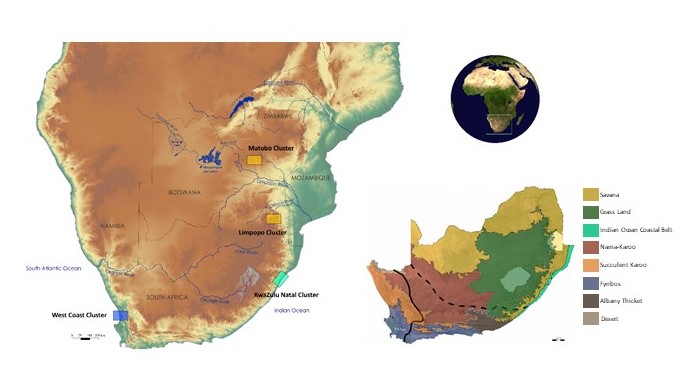The MileStone Age
Late Pleistocene chronology and technologies in southern Africa
L’étude des sociétés préhistoriques du Pléistocène supérieur en Afrique australe se construit aujourd’hui sur deux grandes problématiques scientifiques que sont l’origine des comportements modernes d’une part, et l’origine des cultures matérielles San d’autre part. Ces deux perspectives recouvrent l’étude de deux phases chronoculturelles que sont le Middle Stone Age (MSA) et le Later Stone Age (LSA). Cette succession MSA/LSA marque un important jalon dans l’histoire des populations humaines, consacrant la dernière grande phase d’expression culturelle des sociétés de chasseurs-collecteurs avant l’adoption des économies agro-pastorales.
Cependant, la distinction entre le MSA et LSA en Afrique est largement héritée des cadres européens du début du 20e siècle, soulevant la question de la légitimité de ces cadres conceptuels. Dans notre projet The MileStone Age, nous interrogeons la réalité des différences techniques entre le MSA et le LSA, nous questionnons les scénarios de transition et soulevons les nœuds épistémologiques qui influencent notre construction des modèles évolutifs. Notre projet propose de fusionner l’étude des assemblages lithiques du MSA et du LSA de façon à promouvoir un récit sur le temps long et à mieux faire valoir la nature et la diversité des mécanismes d’évolution culturelle. Notre projet vise in fine à redéfinir la nature des traditions et des successions techniques en Afrique australe et à clarifier leurs chronologies absolues.

Quatre ensembles de sites provenant de trois biomes différents d’Afrique australe, couvrant les stades isotopiques marins 5 à 1, sont étudiés : Diepkloof Rock Shelter et Elands Bay Cave (Western Cap, Afrique du Sud) ; Sibhudu et Umbeli Belli (KwaZulu-Natal, Afrique du Sud) ; Heuningneskrans et Bushman Rock Shelter (Limpopo, Afrique du Sud) ; Pomongwe et Bambata (Matobo, Zimbabwe). Tous ces sites présentent de longues séquences sédimentaires finement stratifiées enregistrant des occupations humaines sur l’ensemble du Pléistocène supérieur.
Les études de technologie lithique sont organisées selon trois axes :
- celui des « intervalles chronoculturels » est consacré à la définition des techno-complexes ;
- celui des « contacts chronoculturels » se penche sur les scénarios de transition ;
- celui des « attributs techno-fonctionnels » est focalisé sur les outils lithiques innovants qui sont apparus en différents lieux et à différents moments du Pléistocène supérieur en Afrique australe.
En ce qui concerne les études géochronologiques, deux méthodes sont mises en œuvre : la luminescence stimulée optiquement (OSL) appliquée aux sédiments et la méthode des séries de l’uranium appliquée aux biominéraux. Ces deux méthodes bénéficient d’avancées méthodologiques récentes qui permettent d’aller au-delà des limites imposées par l’actuel état de l’art.
Le projet est programmé pour quatre ans, pour un budget total de 417 k€. Archeosciences Bordeaux est en charge des datations par OSL, tandis que l’IPREM réalise les datations par les séries de l’uranium. Le LAMPEA organise les études de technologie lithique en collaboration avec trois équipes des universités de Tübingen (Allemagne), de Liège (Belgique) et de Cape Town (Afrique du Sud), accueillant des chercheurs jeunes ou expérimentés, européens ou africains de différents instituts (composition de l’équipe, au bas de la page).
L’équipe du projet :
- Chantal Tribolo
- Guillaume Porraz, LAMPEA
- John Parkington, Dpt of Archaeology, University of Cape Town, South Africa
- Veerle Rots, Traceolab, University of Liege, Belgium
- Nicholas Conard, Senckenberg Center for Human Evolution and Palaeoenvironment, Early Prehistory and Quaternary Ecology, University of Tübingen, Germany
- Christophe Peychéran, IPREM, CNRS-University Pau et les Pays de l’Adour, France
- Will Archer, Dpt of Archaeology and Anthropology, National Museum, Bloemfontein, South Africa
- Gregor Bader, Senckenberg Center for Human Evolution and Palaeoenvironment, University of Tübingen, Germany
- Gaëlle Barbotin, IPREM, CNRS-University Pau et les Pays de l’Adour, France
- Fanny Claverie, IPREM, CNRS-University Pau et les Pays de l’Adour, France
- Dries Cnuts, Traceolab, University of Liege, Belgium
- Katja Douze, APA, University of Geneva, Switzerland
- Asmodée Galy, IPREM, CNRS-University Pau et les Pays de l’Adour, France
- Marina Igreja, Laboratorio de Arqueociências da DGPC, Ministerio da Cultura, Lisboa, Portugal
- Iris Guillemard, Dpt of Archaeology, University of Witswatersrand, South Africa
- Joseph Matembo, Dpt of Archaeology, University of Cape Town, South Africa
- Norbert Mercier
- Giulia Ricci,, LAMPEA
- Viola Schmid, Senckenberg Center for Human Evolution and Palaeoenvironment, University of Tübingen, Germany, Faculty of Archaeology, Leiden, Netherlands
- Nicolas Teyssandier, TRACES
- Manuel Will, Senckenberg Center for Human Evolution and Palaeoenvironment, University of Tübingen, Germany
Publié le 1er janvier 2022 , mis à jour le 21 février 2024.

